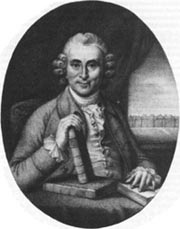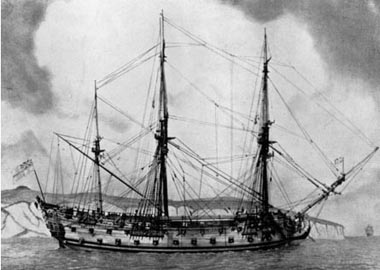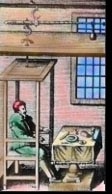James Lind (1716-1794)
|  Trained in Edinburgh, Lind entered the British
Navy as a surgeon's mate in 1739. During an extended trip in the
English Channel in 1747 on the 50 gun, 960 ton H.M.S.Salisbury,
Lind carried out a decisive experiment (the first planned, controlled
clinical trial) that changed the course of naval medicine. He
knew that scurvy (the great sea plague) often killed two-thirds
of a ship's crew. Their diet included 1 lb. (0.45 kg) and 4 oz.
(113.4 g) of cheese bisquits daily, 2 lb. 0.90 kg) salt beef twice
weekly, 2 oz. (56.7 g) dried fish and butter thrice weekly, 8
oz. (226.8 g) peas four days a week, and one gallon (3.79 l) of
beer daily. Deprived of vitamin C, sailors fell prey to scurvy.
By adding fresh fruit to their diet, Lind fortified their immune
systems so that British sailors no longer perished. Krehl1
quotes from Lind's Treatise on the Scurvy (1753). Trained in Edinburgh, Lind entered the British
Navy as a surgeon's mate in 1739. During an extended trip in the
English Channel in 1747 on the 50 gun, 960 ton H.M.S.Salisbury,
Lind carried out a decisive experiment (the first planned, controlled
clinical trial) that changed the course of naval medicine. He
knew that scurvy (the great sea plague) often killed two-thirds
of a ship's crew. Their diet included 1 lb. (0.45 kg) and 4 oz.
(113.4 g) of cheese bisquits daily, 2 lb. 0.90 kg) salt beef twice
weekly, 2 oz. (56.7 g) dried fish and butter thrice weekly, 8
oz. (226.8 g) peas four days a week, and one gallon (3.79 l) of
beer daily. Deprived of vitamin C, sailors fell prey to scurvy.
By adding fresh fruit to their diet, Lind fortified their immune
systems so that British sailors no longer perished. Krehl1
quotes from Lind's Treatise on the Scurvy (1753).
|
On the 20th of May, 1747, I selected 12 patients in the scurvy, on
board the Salisbury at sea. Their cases were as similar as I could
have them. They all in general had putrid gums, the spots and lassitude,
with weakness of their knees. They lay together in one place, being
a proper apartment for the sick in the fore-hold: and had one diet
common to all, viz, water-gruel sweetened with sugar in the morning;
fresh mutton-broth oftentimes for dinner; at other times light puddings,
boiled biscuit with sugar, etc., and for supper, barley and raisins,
rice and currants, sago and wine, or the like. Two of these were ordered
each a quart of cyder a day. Two other took 25 drops of elixer of
vitriol 3 times a day, upon an empty stomach; using a gargle strongly
acidulated with it for their mouths. Two others took 2 spoonfuls of
vinegar 3 times a day, upon an empty stomach; having their gruels
and their other food sharpened with vinegar, as also the gargle for
their mouth. Two of the worst patients, with the tendons in the ham
quite rigid (a symptom none of the rest had) were put under a course
of sea water. Of this they drank half a pint every day, and sometimes
more or less, as it operated, by way of gentle physic. Two others
had each two oranges and one lemon given them every day. These they
ate with greediness, at different times, upon an empty stomach. They
continued but six days under this course, having consumed the quantities
that could be spared. The 2 remaining patients took the bigness of
a nutmeg 3 times a day, or an electary recommended by an hospital-surgeon,
made of garlic, mustard-seed, horse-radish, balsam of Peru, and gum
myrh; using for common drink barley-water boiled with tamarinds; by
which, with the addition of cream of tartar, they were gently purged
3 or 4 times during the course. The consequence was, that the most
sudden and visible good effects were perceived from the use of oranges
and lemons; one of those who had taken them, being at the end of 6
days fit for duty. The spots were not indeed at that time quite off
his body, nor his gums sound; but without any other medicine than
a gargle for his mouth he became quite healthy before we came into
Plymouth which was on the 16th of June. The other was the best recovered
in his condition; and being now pretty well, was appointed nurse to
the rest of the sick. Next to oranges, I thought the cyder had the
best effects. It was indeed not very sound. However, those who had
taken it, were in a fairer way of recovery than the others at the
end of the fortnight, which was the length of time all these different
courses were continued, except the oranges. The putrification of their
gums, but especially their lassitude and weakness, were somewhat abated,
and their appetite increased by it.
Lind sailed on the HMS Salisbury in 1747. An early innovator
in food technology, Lind obtained pure drinking water from the condensate
in steam during cooking with sea water. He also described how to preserve
citrus juice.
Let the squeezed juice of these fruits be well cleared from the pulp
and depurated by standing for some time; then poured off from the
gross sediment; or, to have it stay purer, it may be filtered. Let
it them be put into any clean oven vessel of china or stoneware which
should be wider at the top than at the bottom. so that there may be
the largest surface above to favor the evaporation... Into this pour
the purified juice: and put it into a pan of water come almost to
a boil and continue nearly in the state of boiling ... until the juice
is found to be the consistency of a thick syrup when cold... It is
then when cold, to be corked up in a bottle for use. Two dozen of
good oranges weighing 5 pounds 4 ounces, will yield 1 pound 9 ounces
and a half of depurated juice; and when evaporated there will remain
about 5 ounces of the rob or extract; which in bulk will be equal
to less than 3 ounces of water. So that thus the acid, the virtues
of 12 dozens of lemons or oranges, may be put into a quart bottle,
and preserved for several years.
| 
|
|
Drawing based on a model created from architectural plans.
|
Lind published two books2: An Essay on Preserving the Health
of Seamen in the Royal Navy (1757); Essay on Diseases Incidental to
Europeans in Hot Climates (1768). Easily available, his books were translated
into German, French, and Dutch. Lind's landmark emphasis on the crucial
importance of dietary supplements antedates modern practices. Lind's
work defeated scurvy from the treatment regimen he discovered, but fifty
years had to pass and many more lives lost before the British Admiralty
required fresh citrus fruit on all ships. This was but another sad example
of damage done when politics neglects science, and unqualified autocrats
make final decisions on matters concerning health.
References
1. Krehl, W. A., James Lind, M.D. J. Nutr. 50, 3, 1953.
2. Stewart, C.P., and Guthrie, D. Lind's Treatise on Scurvy. A bicentenary
volume containing a reprint of the first edition of A Treatise of the
Scurvy by James Lind, M.D., with additional notes. University Press,
Edinburgh, 1953.
Additional Resources
http://pc-78-120.udac.se:8001/WWW/Nautica/Medicine/Lind(1753).html
This site quotes from Lind's original work, A Treatise of the Scurvy
in Three Parts. Containing an inquiry into the Nature, Causes and Cure
of that Disease, together with a Critical and Chronological View of
what has been published on the subject. A. Millar, London, 1753. Carpenter,
K.J. The history of scurvy and vitamin C. Cambridge University Press.
Cambridge, 1986.
Copyright ©1997
|

 Trained in Edinburgh, Lind entered the British
Navy as a surgeon's mate in 1739. During an extended trip in the
English Channel in 1747 on the 50 gun, 960 ton H.M.S.Salisbury,
Lind carried out a decisive experiment (the first planned, controlled
clinical trial) that changed the course of naval medicine. He
knew that scurvy (the great sea plague) often killed two-thirds
of a ship's crew. Their diet included 1 lb. (0.45 kg) and 4 oz.
(113.4 g) of cheese bisquits daily, 2 lb. 0.90 kg) salt beef twice
weekly, 2 oz. (56.7 g) dried fish and butter thrice weekly, 8
oz. (226.8 g) peas four days a week, and one gallon (3.79 l) of
beer daily. Deprived of vitamin C, sailors fell prey to scurvy.
By adding fresh fruit to their diet, Lind fortified their immune
systems so that British sailors no longer perished. Krehl1
quotes from Lind's Treatise on the Scurvy (1753).
Trained in Edinburgh, Lind entered the British
Navy as a surgeon's mate in 1739. During an extended trip in the
English Channel in 1747 on the 50 gun, 960 ton H.M.S.Salisbury,
Lind carried out a decisive experiment (the first planned, controlled
clinical trial) that changed the course of naval medicine. He
knew that scurvy (the great sea plague) often killed two-thirds
of a ship's crew. Their diet included 1 lb. (0.45 kg) and 4 oz.
(113.4 g) of cheese bisquits daily, 2 lb. 0.90 kg) salt beef twice
weekly, 2 oz. (56.7 g) dried fish and butter thrice weekly, 8
oz. (226.8 g) peas four days a week, and one gallon (3.79 l) of
beer daily. Deprived of vitamin C, sailors fell prey to scurvy.
By adding fresh fruit to their diet, Lind fortified their immune
systems so that British sailors no longer perished. Krehl1
quotes from Lind's Treatise on the Scurvy (1753). 